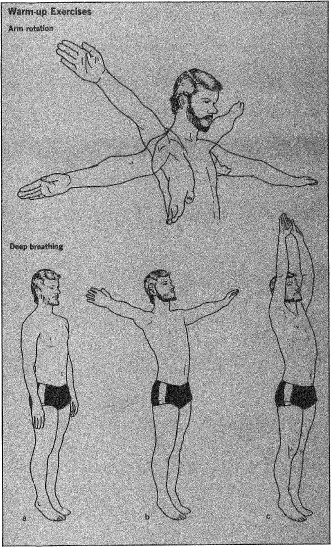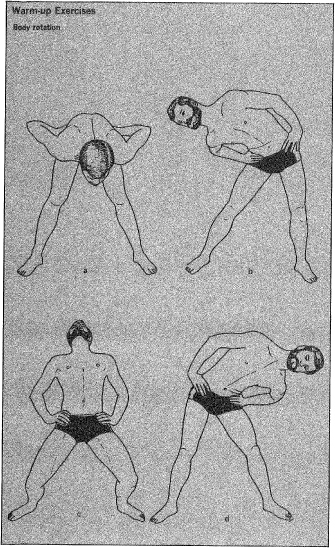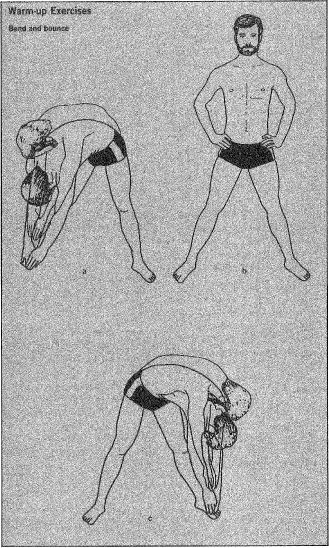The Target: Total Fitness - Warm-up and cool-down
The rules for warm-up and cool-down are simple. A gradual progression in intensity of exertion should introduce the fitness session. At the end of the session there should be a tapering-off period, during which the body returns to normal. Actually, authorities disagree to some extent on the need for a warm-up and cool-down. But most feel that a preexercise warm-up should be mandatory for everyone taking part in demanding exercises. For those who have not exercised seriously for a long time and who are restarting, the warm-up should last 10 to 15 minutes. For those in better condition, the warm-up can be shorter, even as little as four or five minutes.
An effective warm-up period has several physiological effects. For one thing, it stretches ligaments. The warm-up also raises body temperature and increases cardiovascular activity. In all such ways the warm-up prepares the body for exercise.
Warm-up: What and How?
The warm-up begins, for best results, with light, rhythmical exercises performed at a slow pace. Stretching and deep breathing both loosen the muscles and increase the body's oxygen supply. Stretching also makes deeper breathing possible.
Most sets of warm-up exercises include about four or five very simple movements. The body should be sweating lightly when the set is done. A typical group of four exercises is shown.
1. The deep-breathing exercise requires that you rise on your toes, inhaling deeply at the same time. First extend your arms straight out to the side. While breathing in and rising on your toes, raise your arms from shoulder level until your hands come together over your head. That position should be held for a moment or two. Then lower your arms to your sides and exhale while returning to the flat-footed standing position. Six to a dozen repetitions will suffice.
2. The arm rotation exercise calls again for extension of your arms straight out to the sides from your shoulders. The hands are then rotated in circles about a foot in diameter. Your hands should describe 20 circles while rotating forward and 20 more while rotating in the other direction.
3. In the body rotation exercise, after placing your feet wide apart and bending forward at the waist, rotate your body from the belt up in slow circles. The upper body should describe circles large enough to stretch all the affected muscles. You can rotate five times in one direction, five more in the other.
4. In the bend and bounce , bend far over with your legs spread apart. Try to touch your fingers to the ground three times in front of your right foot, then three times in front of the left. The touching should be done with downward bouncing motions of the body. The beginner may want to bend without touching the ground at all—just bouncing and bending low. The bend and bounce should stretch the back muscles. The tension on the muscles should be increased daily until flexibility returns.



The same warm-up series can include other exercises designed to get the feet in tune with the body. This final set of movements helps prevent the damage that can be inflicted on the feet by neglect or a premature start on the exercise program proper.
- • While sitting, pick up a dozen marbles with the toes of the right foot. Drop each marble in turn into a container. The procedure is repeated with the other foot.
- • Again while sitting on the floor, with one leg crossed over the other at the knee, take hold of the toes of the upper leg with both hands. Using that pressure as resistance, try to curl your toes as hard as you can. The exercise should be repeated with the other foot.
- • Again while seated on the floor, flex one leg at the knee and place that foot on the floor. Hold the other leg straight out with the toes pointed, and describe a full circle with the foot. Repeat this exercise 10 times with each foot.
- • Standing with your hands on your hips, rise up on tiptoe, then lower yourself to the floor quickly. The exercise should be repeated 10 times in the early sessions, then increased to 20 or more times for later warm-ups.
Note that you can invent your own warm-up exercise routine. It should, if possible, parallel the exercises that you will be performing in the main fitness activity. Indeed, warm-up movements may be identical to those later exercises, particularly where sports are concerned. The handball player warms up with throwing exercises and special shots. The tennis player warms up by rallying easily until his muscles are completely ready for the sometimes violent demands of the regular game.
Those who decide to create their own warm-up routines should keep in mind the basic characteristics of any satisfying set of exercises. Whole-body activity such as running in place or jumping is usually included in a warm-up. The warm-up set should also exercise each of the major body areas: trunk and hips; arms and shoulders; neck; legs and knees; and ankle and foot.
The Cool-off
If a careful warm-up helps prevent muscle soreness, what does the cool-off period do? Can't you just lie down and let the sweat dry until you go to the shower?
In answer to the first question, the cool-down period allows the blood to be gradually redistributed in the normal resting pattern. The body temperature returns to normal. Your heart rate goes back to normal.
The answer to the second question is No. The best procedure is to keep moving for at least several minutes after vigorous exercise. You are trying to get your breathing and heart rate back to normal. You want your body literally to cool down.
Why not just lie down—or sit down—to cool off? An abrupt and complete cessation of the exercise reduces the flow of venous blood to the heart. A complete stop may also decrease the heart stroke volume. The heart may have to work much harder to maintain an adequate blood flow. Thus abruptly terminating exercise may lead to dizziness, fainting, shock, or other strain on the heart. Most heart attacks that afflict older persons in exercise situations take place during the postexercise period. The ideal cool-down exercise is slow jogging or walking. At the same time the subject should swing his or her arms. Once the pulse rate has reached about 120—a ten-second count of 20—the readjustment has been largely accomplished.
Showers, Saunas, and Steam Baths
Hot showers, saunas, and steam baths also are not recommended for the immediate postexercise period. The hot shower, sauna, or steam bath merely adds strain. While they can be enjoyable and relaxing, be sure to wait until body temperature and heart rate has returned to normal before indulging in them.
Ice-cold showers present their own dangers. Ice-cold water flowing over the chest increases the blood pressure. It also raises the heart rate and cardiac output. While a healthy individual can tolerate the additional load, a person with cardiovascular problems could experience difficulties. Such a person may or may not know of his condition; the ice-cold shower would take its toll in either case.
The need to shower after heavy exercise cannot, of course, be minimized. A noted educator once stated that a social gap exists between those who bathe daily and those who do not. The gap would widen if the shower were not a postexercise priority. But the shower water should have a moderate temperature—about 70 degrees. At that temperature the shower tones the skin while also cleaning.
Some experts recommend a warm shower followed by a cool one. The warm shower opens the skin pores; the cool one closes them. Medical authorities agree generally that the practice has merit for persons in good health.

Comment about this article, ask questions, or add new information about this topic: